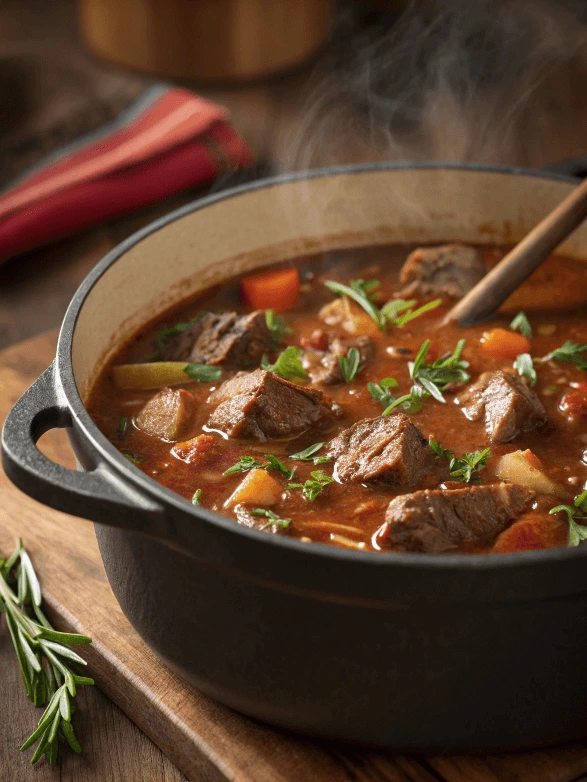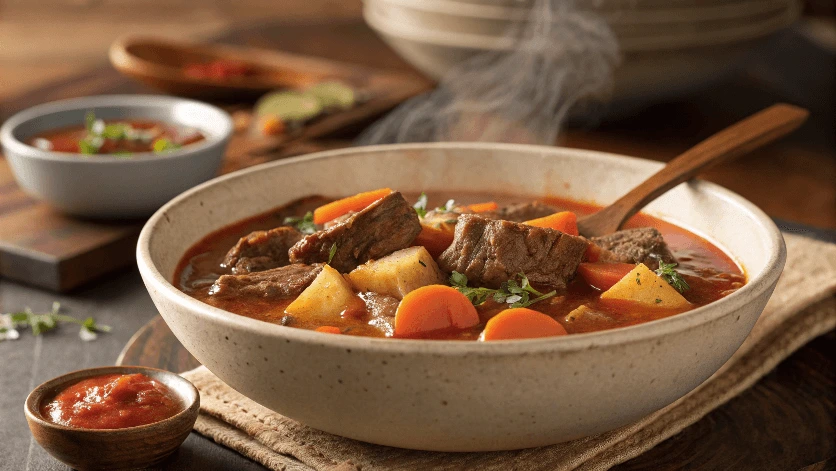There’s something magical about a pot of simmering beef stew—rich, hearty, and full of deep flavors. But have you ever felt like something was missing? That one special touch that takes a good stew to an unforgettable dish? That’s where tomato paste comes in! Why add tomato paste to beef stew? Because it’s the secret ingredient that brings depth, balance, and richness, transforming an ordinary recipe into a bold, flavorful masterpiece.
The beauty of tomato paste is its simplicity and power. Just a small amount enhances the umami, sweetness, and thickness of your stew, creating a well-rounded, deeply satisfying dish. It blends effortlessly, elevating every spoonful with a hint of tangy warmth. Whether you’re making a classic beef stew or experimenting with flavors, this upgrade is a game-changer. Keep reading to discover how to use it perfectly and unlock the best-tasting stew you’ve ever made!
Table of Contents
The Role of Tomato Paste in Beef Stew

How Tomato Paste Enhances Depth and Complexity
Tomato paste is a powerhouse ingredient when it comes to making beef stew. It delivers a rich, bold flavor that enhances every bite. Its concentrated taste deepens the overall profile, making the dish more satisfying.
Next, tomato paste thickens the broth, creating a velvety texture. Without it, a beef stew might feel too watery. The paste binds ingredients together, giving the stew a cohesive consistency.
Additionally, tomato paste provides a balance between acidity and sweetness. This contrast lifts the other flavors, making them more pronounced. Slow cooking allows the paste to integrate fully, enhancing the stew’s complexity.
Using tomato paste also brings out the umami in beef. It interacts with the meat’s natural flavors, making each spoonful more robust.
The Science Behind Tomato Paste’s Flavor Boost
Tomato paste intensifies the Maillard reaction, which occurs when proteins and sugars break down under heat. This reaction creates a deep, caramelized taste in beef stew.
| Component | Effect on Stew |
|---|---|
| Acidity | Balances richness |
| Sugar | Adds mild sweetness |
| Glutamates | Enhances umami taste |
| Pectin | Helps thicken the broth |
Additionally, tomato paste contains pectin, a natural thickener. This gives the stew a hearty texture without adding extra starches.
When combined with browned beef, tomato paste caramelizes, intensifying the stew’s depth. Stirring it into the pot before adding liquid allows it to develop a toasted, slightly smoky taste.
And if you’re looking for the ultimate upgrade, check out The One Ingredient Upgrade for Better Beef Stew to enhance every bite!
How Tomato Paste Affects the Texture and Consistency
Thickening Benefits and Its Impact on the Broth
Tomato paste plays a crucial role in beef stew, giving it a thick and velvety texture. Unlike fresh tomatoes, which release excess water, tomato paste is concentrated, adding richness without diluting the broth. This ingredient creates a luxurious, spoon-coating consistency that enhances every bite.
First, tomato paste binds with the natural fats in the stew, creating a smooth emulsion. This process helps distribute flavors evenly. Next, it reduces excess liquid, preventing a thin or watery consistency. Also, as the stew simmers, the paste caramelizes slightly, deepening the dish’s overall complexity.
A small amount goes a long way. Adding too much can overpower other flavors, so balance is key. Stir it in early for better incorporation. For best results, let it cook for a minute before adding liquid to develop its natural sweetness.
Comparison of Thickening Agents in Beef Stew
| Thickening Agent | Texture Effect | Flavor Impact | Best Usage Tip |
|---|---|---|---|
| Tomato Paste | Thick and smooth | Slight sweetness, umami boost | Cook before adding liquid for better depth |
| Flour | Creamy but dense | Neutral | Whisk with broth to avoid clumps |
| Cornstarch | Glossy and silky | No added flavor | Mix with cold water first to prevent lumps |
| Potatoes | Hearty and rustic | Slightly earthy | Use mashed for thickening or cubed for texture |
Pro Tip: If you’re craving a unique spin on beef stew, try this Hawaiian Beef Stew Recipe for a tropical twist!
The Perfect Balance: Avoiding an Overpowering Tomato Taste
Tomato paste enhances the stew, but too much can dominate the dish. Finding the right balance is essential.
- Start small – A tablespoon or two is enough for a large pot.
- Cook it down – Sautéing before adding broth reduces acidity and deepens flavor.
- Pair it well – Complementary ingredients like garlic, onion, and carrots balance the tomato’s sharpness.
- Adjust seasoning – A pinch of sugar or a splash of balsamic vinegar can neutralize excess acidity.
- Taste as you go – Adding too much paste at once can be overpowering. Stir, simmer, and adjust gradually.
By using tomato paste wisely, you can create a stew that is thick, flavorful, and perfectly balanced without overwhelming the dish.
Choosing the Best Tomato Paste for Beef Stew
Types of Tomato Paste and Their Flavor Profiles
Tomato paste comes in different varieties, and choosing the right one can make all the difference in your beef stew. The type you use will affect the stew’s depth, acidity, and overall flavor balance.
Double-concentrated tomato paste packs twice the flavor intensity of regular paste. It’s perfect for those who love bold, rich flavors. Sun-dried tomato paste has a more complex and slightly smoky taste, adding a unique layer to your stew. Meanwhile, organic tomato paste offers a fresher, less processed flavor without additives or preservatives.
For a deep umami boost, opt for roasted tomato paste. The roasting process enhances its natural sweetness while reducing acidity. If you prefer a milder, less tangy option, go for Italian-style tomato paste, which often includes added seasonings like basil and oregano.
Comparison of Tomato Paste Types:
| Type of Tomato Paste | Flavor Profile | Best For | Usage Tip |
|---|---|---|---|
| Regular Tomato Paste | Balanced, slightly tangy | General use in stews | Cook briefly before adding liquid |
| Double-Concentrated | Richer, more intense | Bold-flavored stews | Use less to avoid overpowering flavors |
| Sun-Dried | Deep, smoky, slightly sweet | Gourmet-style stews | Adds a unique twist to traditional recipes |
| Organic | Fresh, natural taste | Clean-eating recipes | Great for those avoiding additives |
| Roasted | Sweet and caramelized | Slow-cooked stews | Adds extra depth and richness |
Pro Tip: Want to explore a different kind of slow-cooked dish? Check out this Ground Venison Recipe for a wild, gamey alternative to beef stew!
Fresh vs. Canned Tomato Paste: Which One Works Best?
When choosing between fresh and canned tomato paste, both have their strengths. It all depends on the texture and flavor profile you want in your beef stew.
- Canned tomato paste is more concentrated and has a longer shelf life.
- Fresh tomato paste delivers a lighter, fruitier flavor.
- Canned paste caramelizes better when sautéed in oil.
- Fresh paste has more natural acidity, which balances fatty meats.
- For convenience, canned tomato paste is the better option.
If using fresh tomatoes, you’ll need to cook them down longer to achieve the thick consistency of canned paste. However, fresh paste retains more nutrients and a natural garden-fresh taste. If time is short, stick with canned for its ease and versatility.
By choosing the right type of tomato paste, you can tailor your beef stew’s depth and richness to your preference, creating a dish that’s both flavorful and well-balanced.
When and How to Add Tomato Paste for the Best Results
Cooking Techniques That Maximize Tomato Paste’s Impact
Adding tomato paste at the right moment can enhance the flavor and texture of your beef stew. If added too early, it may lose its depth. If added too late, it may not blend well with other ingredients. The key is to cook it properly before incorporating liquids.
Start by sautéing tomato paste in oil or butter for at least one to two minutes. This helps caramelize its natural sugars, reducing acidity and deepening the stew’s flavor. Cooking it directly with onions and garlic also enhances its umami impact. After it darkens slightly in color, you know it’s ready to blend with broth or stock.
For slow-cooked stews, add tomato paste early, allowing it to meld with other ingredients over time. For a brighter, fresher tomato note, stir it in during the final 30 minutes.
Tomato Paste Cooking Tips for Maximum Flavor
| Step | Method | Why It Works |
|---|---|---|
| Sauté First | Cook in oil before adding liquids | Caramelizes sugars, enhances depth |
| Simmer Slowly | Let it blend with broth and seasonings | Balances acidity and mellows flavor |
| Pair with Aromatics | Mix with onions and garlic before liquid | Enhances umami and richness |
| Adjust Timing | Add early for deep flavor, late for brightness | Controls overall stew balance |
Pairing Tomato Paste with Other Ingredients for a Richer Stew
Pairing tomato paste with complementary ingredients ensures a well-rounded stew. Here are some of the best pairings:
- Beef broth – Enhances meaty richness and balances acidity.
- Worcestershire sauce – Adds umami and depth.
- Carrots & celery – Naturally sweeten the stew and counter acidity.
- Garlic & onions – Build a strong, aromatic base.
- Bay leaves & thyme – Infuse layers of earthy flavor.
- Red bell peppers – Bring subtle sweetness without overpowering.
If the stew tastes too acidic after adding tomato paste, balance it with a pinch of sugar or a splash of balsamic vinegar. The right pairings ensure your beef stew has a smooth, well-rounded depth of flavor
Common Mistakes When Using Tomato Paste in Beef Stew
Avoiding Acidity Overload and Balancing Flavors
One of the biggest mistakes when using tomato paste in beef stew is creating an overly acidic dish. Tomato paste is naturally tangy, and if not balanced correctly, it can dominate the stew’s flavor. The key is to balance acidity with sweetness and umami-rich ingredients.
To prevent acidity overload, always sauté the tomato paste before adding liquid. This helps neutralize some of the sharpness. Another trick is to pair it with naturally sweet ingredients like carrots, caramelized onions, or bell peppers. If the stew still tastes too sharp, add a pinch of sugar or a splash of balsamic vinegar to round out the flavors.
Here’s how to balance acidity effectively:
| Mistake | Fix | Why It Works |
|---|---|---|
| Adding tomato paste directly to liquid | Sauté it first | Reduces sharpness and enhances sweetness |
| Too much acidity from tomatoes | Add a pinch of sugar or honey | Softens the tartness and balances flavors |
| Lack of depth | Pair with Worcestershire sauce or soy sauce | Adds umami and rounds out the taste |
| Overpowering tomato taste | Use broth and aromatics to blend flavors | Creates a smooth, cohesive stew |
The Right Amount: Finding the Sweet Spot Without Overdoing It
Using the right amount of tomato paste makes all the difference. Too little, and you miss out on richness. Too much, and the stew becomes overwhelmingly tomato-forward instead of balanced. The ideal ratio depends on your serving size and other ingredients.
Guidelines for Using Tomato Paste in Beef Stew:
- For a subtle boost – Use 1 tablespoon for a mild tomato undertone.
- For deep richness – Use 2 tablespoons per 4 cups of broth.
- For a tomato-forward stew – Use 3 tablespoons but balance with sweet ingredients.
- If stew tastes too strong – Add extra broth or potatoes to mellow it out.
The key is to start small and adjust as needed. If the stew tastes too intense, add a bit more broth or a splash of cream to soften the flavors. By carefully finding the right balance, you can enhance your beef stew with tomato paste without overwhelming it.
Frequently Asked Questions (FAQs)
What if I forgot tomato paste in beef stew?
If you forgot tomato paste in beef stew, don’t worry! You can still enhance the flavor by adding a substitute. Try using tomato sauce, ketchup, or finely chopped sun-dried tomatoes for a similar richness. Another option is a splash of balsamic vinegar or Worcestershire sauce to add depth. Next time, sautéing tomato paste early in the cooking process boosts flavor even more!
What gives beef stew depth of flavor?
Beef stew gets its deep, rich flavor from a mix of slow cooking, umami ingredients, and the right seasonings. Tomato paste adds depth by enhancing sweetness and acidity. Other ingredients like garlic, onions, Worcestershire sauce, and herbs layer in complexity. For an even deeper taste, try browning the meat properly and using a long, slow simmer to develop the perfect richness.
What does tomato paste do to meat?
Tomato paste coats the meat with a rich, slightly sweet, and tangy flavor. When sautéed before adding liquid, it helps create a deep umami base that enhances the overall taste. Additionally, tomato paste adds a subtle caramelization effect when it cooks with browned meat, intensifying the stew’s complexity. It also thickens the sauce, giving the stew a heartier texture.
What is the purpose of using tomato paste?
Tomato paste adds depth, richness, and balance to beef stew. It enhances both the sweet and savory notes, making flavors more intense. Additionally, it helps thicken the broth and improves texture. When sautéed before adding liquids, it releases a concentrated, caramelized taste that boosts umami. Adding tomato paste ensures a well-rounded, flavorful stew that tastes slow-cooked and perfectly balanced.
Conclusion: Elevate Your Beef Stew with Tomato Paste
Tomato paste is a game-changer when it comes to making the perfect beef stew. It adds depth, richness, and a well-balanced flavor that takes your dish to the next level. By enhancing both the savory and slightly sweet notes, it creates a complex, hearty taste that lingers with every bite.
In addition to boosting flavor, tomato paste thickens the broth and improves texture, giving your stew that comforting, slow-cooked feel. Using the right amount at the right time ensures a smooth, well-rounded dish without overpowering the other ingredients. Next time you make beef stew, don’t skip this essential upgrade. Try it out and experience the difference! Your stew will never be the same again.

